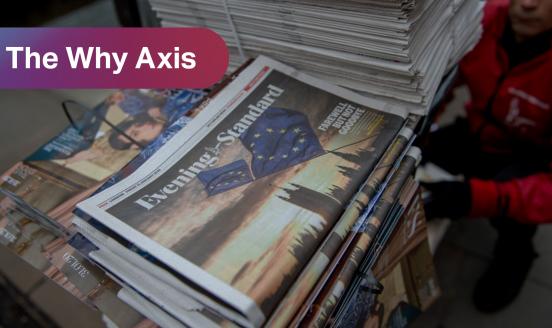Big data and first-degree price discrimination
What’s at stake: first-degree price discrimination - or person-specific pricing, had until recently been considered a theoretical case with unlikely r
Shiller (2014) looks at the issue of first-degree price discrimination with big data, in the context of Netflix subscription. He shows that demographics which could have been used in the past to personalize prices, poorly predict which consumers subscribe. By contrast, modern web-browsing data, with variables which reflect behavior - such as visits to Amazon.com and internet use - do substantially better in predicting consumer subscriptions. He then presents a model to estimate demand for Netflix services and simulate what would have been the outcome if 1st degree price discrimination had been implemented instead.
Simulations show that the increase in profits made feasible by first-degree price discrimination based on web-browsing is much higher (12.2%), rather than when just demographics (0.8%), are used to predict individual reservation values. Shiller argues that this meaningful profit increase made possible by web browsing data supports the argument that first-degree PD will evolve from merely theoretical to practical.
Baker, Kiewell and Winkler look at the issue from the perspective of firms. They estimate that on average, a 1 percent price increase translates to an 8.7 percent increase in operating profits (assuming no loss of volume) and yet up to 30 percent of the thousands of pricing decisions companies make every year fail to deliver the best price. They argue the most exciting examples of using big data actually transcend pricing and touch on other aspects of a company’s commercial engine.
For example, “dynamic deal scoring” provides price guidance at the level of individual deals, decision-escalation points, incentives, performance scoring, and more, based on a set of similar win/loss deals. Mikians et al. (2012) empirically demonstrate the existence of not only of first degree price but also search discrimination (e.g. users with a particular profile are steered towards appropriately priced products) on the Internet markets.
Kramer and Kalka (2016) focus on four pricing models, including flexible prices, which are dependent on demand and customer profile. This “dynamic pricing” is not openly communicated to the customers and tries to fully exploit what the target group is willing to pay. Kramer and Kalka argue that the perception and psychological price evaluation by the customer always have to be considered especially with regard to one-to-one pricing policy, which some companies see as the biggest opportunity for future pricing on the basis of big data.
Regner and Riener (2017) show that the attempt to lift anonymity on the internet to increase revenues may indeed backfire. They look at the effect of reduction of anonymity on consumers' purchase decisions at an online music store with Pay-What-You-Want (PWYW)-like pricing and in an internet experiment mimicking the real world situation. Revealing the customer's name, email, and payment to the artist (seller) led to insignificantly higher payments, although it drastically reduced the number of customers purchasing. Overall, the regime led to a revenue loss of 25%. In the online experiment, revenue drops by 35%.
These results suggest that the positive effect of reduced anonymity, previously established for donation or public goods contexts, does not extend to a consumption environment. Instead, the substantial opt-out of customers is likely to be motivated by concerns about privacy.
A 2015 report from the White House Office of Economic Advisers found that companies are presently experimenting with three broad pricing strategies: (1) experiments that randomly manipulate prices to learn about demand; (2) efforts to steer consumers towards particular products without altering their prices; and (3) using big data to customize prices to individual buyers. Research on the prevalence of these pricing practices suggests that experiments and steering are common on some web sites, while cases of personalised pricing remain limited.
The report mentions some evidence that personalised pricing could prove very profitable, providing strong incentives for companies to continue experimenting with these tools. Choe, King and Matsushima (2016) show that this might not be the case.
They develop a product differentiation model of two symmetric firms in which the show that when firms apply big data techniques that facilitate personalized pricing strategies (like 1st degree price discrimination) they become worse off (in terms of profitability). The reason for this surprising result is that the increased flow of information about consumers preferences (that facilitates 1st degree price discrimination) also intensifies competition in the product market.
Bleiberg and West at Brookings argue that risk-based pricing - an approach popular with many insurers - could become a worrisome issue, if customers were priced out of the market because of a factor they cannot control (e.g. if health insurance were prohibitively expensive for a person with a genetic disability). Big data could also allow companies to uncover medical conditions that a consumer might not even know about themselves, and higher prices in this case could constitute a strange new type of privacy violation.
The worst-case scenario with big data pricing, however, would involve the treatment of protected classes. Federal law does not allow companies to treat people differently based on race, religion, and several other characteristics but big data pricing could inadvertently lead to higher prices for certain groups in a way that would violate American values and laws.
Ezrachi and Stucke explore how e-commerce and the personalisation of our online environment can give rise to behavioural discrimination. They argue that online behavioural discrimination will differ from the price discrimination we have seen in the retail world in three important respects: first, big data allow the shift from third-degree, imperfect price discrimination to near perfect price discrimination; second, sellers can use big data to target consumers with the right “emotional pitch” to increase overall consumption (the demand curve shifts to the right); third, as more online retailers personalise pricing and product offerings, it will be harder for consumers to discover a general market price and to assess their outside options, thus implying that behavioural discrimination becomes more durable.



